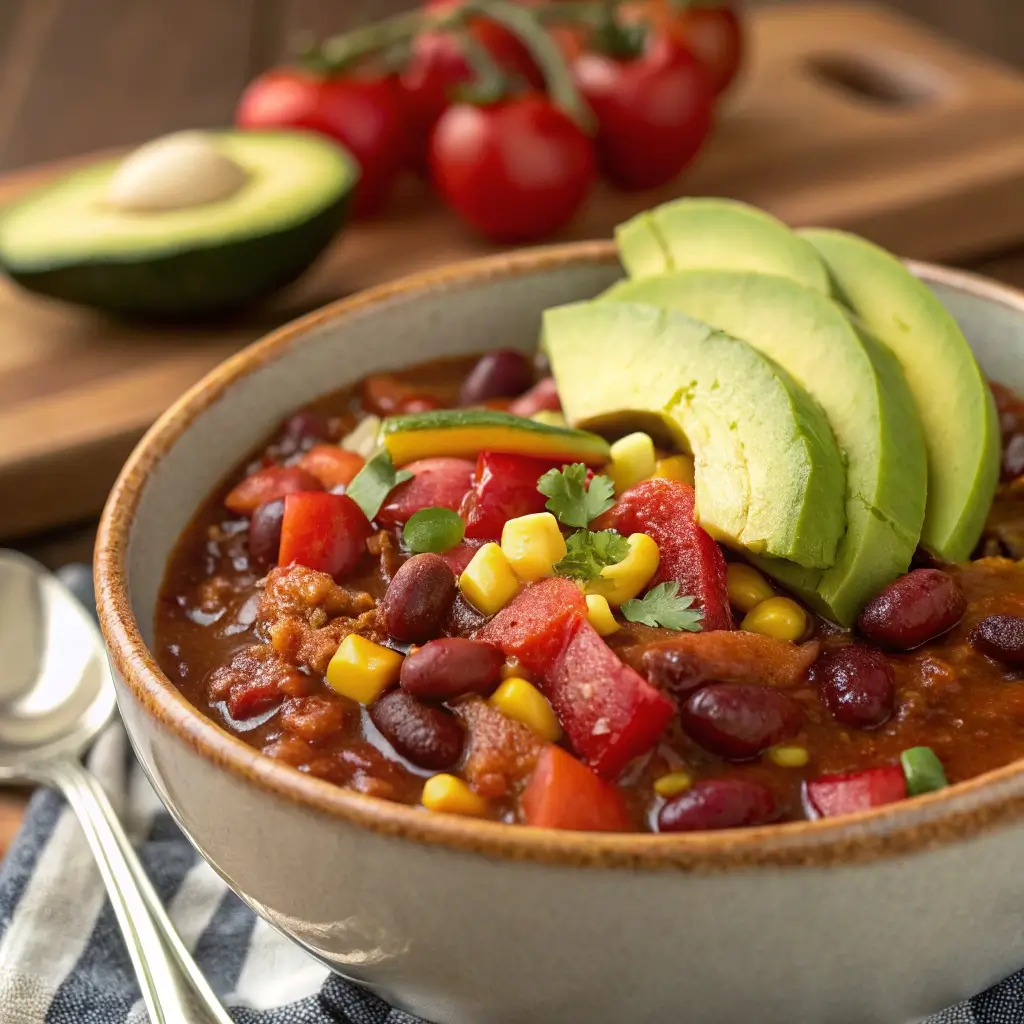Table of Contents
- 1 Why This Vegetarian Chili Works So Well
- 2 Ingredients You’ll Need
- 3 Step‑by‑Step Instructions
- 4 Tips for the Best Vegetarian Chili
- 5 Variations & Adaptations
- 6 What to Serve with Vegetarian Chili
- 7 Storage & Meal Prep Instructions
- 8 Nutrition Snapshot (Approximate per serving, based on about 6 servings)
- 9 Frequently Asked Questions
- 10 Why Vegetarian Chili Belongs in Your Dinner Rotation
When chilly nights set in and your soul craves something comforting, few dishes deliver quite like a rich, hearty vegetarian chili. This meatless chili is packed with beans, fresh vegetables, smoky spices, and satisfying texture—so much so that even committed carnivores will love it. Whether you’re doing Meatless Monday, feeding family or friends, or prepping meals for busy days, this veggie chili is a cozy staple that warms the heart and the appetite.
In the sections ahead, you’ll find the full recipe, tips for customization, variations, serving ideas, storage instructions, and answers to common questions. Let’s dive into a bowl of warm, satisfying comfort.
Why This Vegetarian Chili Works So Well
-
Flavor‑packed without meat — Beans, roasted veggies, chiles, spices all build up layers of taste.
-
High in fiber and plant‑protein — Beans + vegetables = filling and nutritious.
-
One‑pot simplicity — Minimal dishes, easier prep.
-
Adaptable for dietary needs — Gluten‑free, vegan, very adjustable.
-
Meal prep friendly — Makes excellent leftovers; flavors deepen over time.
Ingredients You’ll Need
Here’s a baseline version of ingredients. Feel free to adjust based on what you have or what flavors you prefer.
Vegetables & Beans
-
2 tablespoons olive oil
-
1 large onion, diced
-
1 red bell pepper, diced
-
1 green bell pepper, diced
-
2 medium carrots, diced
-
2 celery stalks, diced
-
3 garlic cloves, minced
-
1 zucchini, diced (optional)
-
1 cup corn kernels (fresh, frozen, or canned)
-
2 cans (15 oz each) kidney beans, drained & rinsed
-
1 can (15 oz) black beans, drained & rinsed
-
1 can (15 oz) pinto beans, drained & rinsed
Tomato & Liquid Base
-
2 cans (14.5 oz each) diced tomatoes (with juice)
-
1 can (6 oz) tomato paste
-
1 cup vegetable broth (low sodium recommended)
-
1 cup water (or more for desired consistency)
Spices & Flavorings
-
2 tablespoons chili powder
-
1 tablespoon ground cumin
-
1 teaspoon smoked paprika
-
1 teaspoon dried oregano
-
½ teaspoon ground coriander (optional)
-
½ teaspoon chipotle powder or chipotle chili flakes (optional, for smokiness)
-
Salt & freshly ground black pepper, to taste
Optional Add‑Ins & Garnishes
-
1 bay leaf
-
1 or 2 jalapeños (seeded) or green chiles for heat
-
A dash of cinnamon (tiny pinch, very optional) to deepen flavor
-
Fresh cilantro, chopped
-
Avocado slices
-
Lime wedges
-
Shredded cheese or dairy‑free cheese
-
Sour cream or Greek yogurt (or dairy‑free alternative)
-
Tortilla chips or cornbread on the side
Step‑by‑Step Instructions
Sauté the Base Vegetables
-
Heat olive oil in a large pot or heavy Dutch oven over medium heat.
-
Add chopped onion, bell peppers, carrots, and celery. Sauté for about 5‑7 minutes until vegetables soften and begin to release their juices.
-
Add garlic and cook another 30 seconds to a minute until fragrant.
Add Tomato Base & Spices
-
Stir in tomato paste, then diced tomatoes (with their juice).
-
Add chili powder, cumin, smoked paprika, oregano, coriander, and optional chipotle or chili flakes. Mix well to coat vegetables.
-
If using bay leaf, add now.
Incorporate Beans, Corn, and Liquids
-
Add all drained beans and corn.
-
Pour in vegetable broth plus additional water to reach your desired chili thickness. Stir gently but thoroughly.
Simmer
-
Bring chili to a gentle boil. Then reduce heat to low to maintain a simmer.
-
Cover partially or fully (depending on pot and how thick you want it). Simmer for at least 25‑30 minutes, stirring occasionally to prevent sticking. Longer simmering (45‑60 minutes) enhances flavor. If simmering too long, add more water or broth as needed.
Adjust Texture & Flavor
-
After simmering, taste and adjust salt, pepper, or spices. Add more chili powder or cumin if needed.
-
If you like a thicker chili, mash a portion of beans in the pot or use a slotted spoon to remove some solids and mash them, or let it simmer uncovered for a few minutes.
-
If too thick, add a splash of broth.
Final Touches & Serving
-
Remove bay leaf if used.
-
Garnish with chopped cilantro, avocado slices, lime wedges, cheese or dairy‑free cheese, and sour cream if desired.
-
Serve hot, with tortilla chips, warm cornbread, or rice on the side.
Tips for the Best Vegetarian Chili
-
Roast some veggies first (like bell peppers, carrots, zucchini) to add caramelized sweet depth. You can roast under broiler or in oven then add.
-
Layer spices: adding spices at different stages (during sautéing, again in simmer) gives more complexity.
-
Keep beans varied: using multiple bean types (kidney, black, pinto) gives texture contrast.
-
Don’t skip the tomato paste: It adds body and rich tomato flavor.
-
Taste often: Especially near the end—adjust salt, heat, or acidity (a squeeze of lime helps).
Variations & Adaptations
Vegan Version
-
Use all plant‑based ingredients. No animal‑derived toppings.
-
If using non‑dairy cheese or sour cream, ensure labeled vegan.
Spicy Variation
-
Add diced jalapeños or hot peppers.
-
Use chipotle chilli powder or smoked paprika.
-
Serve with extra hot sauce on side.
Lentil Boost
-
Add red or brown lentils for extra protein and heartiness. Pre‑soak or rinse well—they cook at a similar rate when simmered.
Squash or Sweet Potato Chili
-
Dice squash (butternut or acorn) or sweet potatoes into cubes and add during simmering. They add sweetness and body.
Slow Cooker or Instant Pot Adaptation
-
Slow Cooker: After sautéing base veggies and spices, transfer to slow cooker. Add beans, tomatoes, liquids. Cook on LOW 4‑6 hours or HIGH 2‑3 hours.
-
Instant Pot: Use “Sauté” setting for base vegetables and spices. Then add beans, tomatoes, and liquids. Pressure cook for 10 minutes, natural release for ~10 minutes.
What to Serve with Vegetarian Chili
-
Classic cornbread (or vegan cornbread)
-
Warm tortilla chips or pita chips
-
Steamed rice or quinoa
-
Warm flour or corn tortillas
-
Simple salad (greens with vinaigrette) to balance richness
-
Toppings bar so guests can customize
Storage & Meal Prep Instructions
-
Let chili cool to room temperature before storing.
-
Store in airtight containers in fridge for up to 4‑5 days.
-
Freeze in portion‑sized freezer bags or containers for up to 3 months.
-
Reheat gently on stovetop, stirring, adding splash of water or broth if needed. In microwave, reheat in intervals.
Nutrition Snapshot (Approximate per serving, based on about 6 servings)
-
Calories: ~350‑420
-
Protein: ~15‑20 grams (mostly from beans)
-
Fiber: ~10‑12 grams
-
Fat: ~8‑12 grams (depending on oil used and optional toppings)
-
Carbohydrates: ~50‑55 grams
-
Sugar: ~6‑8 grams (naturally from vegetables and tomatoes)
Frequently Asked Questions
Is vegetarian chili satisfying without meat?
Yes—beans, varied veggies, and spices provide plenty of texture and flavor. The hearty nature of beans and potential additions (squash, corn, lentils) make it very filling.
Do I need to soak beans first?
No, if using canned beans (pre‑cooked). If you choose to use dry beans, soak or cook them ahead since raw dry beans require longer cook times.
Can I make this gluten‑free?
Yes, ensure all canned goods and vegetable broth are labeled gluten‑free. Most ingredients like beans, tomatoes, veggies are naturally gluten‑free.
How can I control spice level?
Start mild—omit jalapeños or seeds, reduce chili or chipotle powder. Serve spicy condiments on the side so each person can adjust.
Does flavor improve over time?
Absolutely. Chili often tastes better the next day, after flavors meld. For best taste, let it rest, then reheat.
Can I double the recipe?
Yes. Use a larger pot. Adjust simmering time as needed, ensuring you stir occasionally; flavors scale well.
Why Vegetarian Chili Belongs in Your Dinner Rotation
Meatless dinners can sometimes get repetitive, but this vegetarian chili breaks the mold. It’s deeply flavorful, satisfying, and feels indulgent without needing meat. It’s great for budget‑friendly meals, for feeding groups, or simply to feel good about what you serve. On top of that, health benefits of beans, vegetables, fiber, and plant protein make it a smart choice for many dietary goals.
It’s also an ideal way to stretch your cooking habits—to experiment with new veggies, spices, and combinations. Once you master the base, additions become fun and creative.





